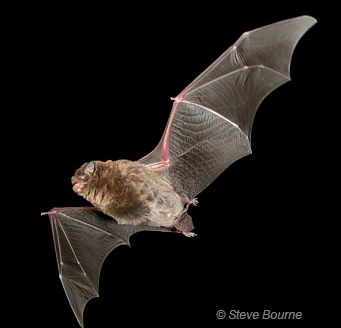Insectivorous bats of Victoria
Southern Bent-wing Bat - Critically endangered
Key points
| Insectivorous bats consume at least half their body weight in insects per night when feeding. They are one of nature’s natural pest controllers and can play an important role in reducing agricultural pests. |
| The loss of habitat, particularly big old tree and loss of tree hollows is a major threat to insectivorous bats – the less big old trees the less bats. |
| Insectivorous bats enter state of torpor (May – September), disturbance to bats in torpor can have a significant impact on their ability to survive. |
| The Southern Bent-wing Bat population at Naracoorte has suffered a 67% reduction over three generations. Insecticides, drought and land use change all being contributing factors. |
| Thermal imaging cameras, laser beam technology and radar tracking systems are now being used to monitor bats. |
| There is high variability in cave use by bats which means non-intrusive monitoring must be carried out regularly throughout the year, over multiple years. |
| It has been difficult to determine the impact of windfarms on Southern Bent-wing Bats because there have been limited requirements on operators to search for mortalities and report findings. |
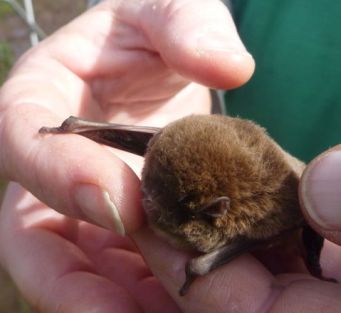
Chocolate Wattled Bat
Insectivorous bats of Victoria
These are the most abundant species of bats. There are 24 species in Victoria. Insectivorous bats are generally tiny; they are sometimes referred to as microbats. People are not usually aware of their presence due to their nocturnal behaviour and their ultrasonic calls which are inaudible to the human ear.
| Species | Scientific name | Status Victoria |
| White-striped Free-tailed Bat | Austronomus australis | |
| Gould’s Wattled Bat | Chalinolobus gouldii |
|
| Chocolate Wattled Bat | Chalinolobus morio |
|
| Little Pied Bat | Chalinolobus picatus | |
| Eastern False Pipistrelle | Falsistrellus tasmaniensis |
|
| Miniopterus schreibersii bassanii | Critically Endangered | |
| Eastern Bent-wing Bat | Miniopterus schreibersii oceanensis | Critically Endangered |
| Large-footed Myotis | Myotis macropus |
|
| South-eastern Long-eared Bat | Nyctophilus corbeni | Endangered |
| Lesser Long-eared Bat | Nyctophilus geoffroyi |
|
| Gould’s Long-eared Bat | Nyctophilus gouldi |
|
| Southern Free-tailed Bat | Ozimops planiceps | |
| Inland Free-tailed Bat | Ozimops petersi | |
| Ride's Free-tailed Bat | Ozimops ridei | |
| Eastern Horseshoe Bat | Rhinolophus megaphyllus megaphyllus | Endangered |
| Yellow-bellied Sheathtail Bat | Saccolaimus flaviventris | Vulnerable |
| Inland Broad-nosed Bat | Scotorepens balstoni |
|
| Little Broad-nosed Bat | Scotorepens greyii | |
| Eastern Broad-nosed Bat | Scotorepens orion | |
| White-striped Freetail Bat | Tadarida australis | |
| Inland Forest Bat | Vespadelus baverstocki | |
| Large Forest Bat | Vespadelus darlingtoni |
|
| Southern Forest Bat | Vespadelus regulus |
|
| Little Forest Bat | Vespadelus vulturnus |
|
Breeding time - October to December
- Gould's Long-eared Bat Nyctophilus gouldi; giving birth to one or two young (Nov-Dec).
- Gould's Wattle Bat Chalinolobus gouldii; start of birthing to two young (Nov-Dec).
- Inland Broad-nosed Bat Scotorepens balstoni; giving birth to one or two young (Oct-Nov).
- Lesser Long-eared Bat Nyctophilus geoffroyi; giving birth to one or two young (Oct-Nov).
- Little Forest Bat Vespadelus vulturnus; giving birth to one young (Nov-Dec).
- Southern Forest Bat Vespadelus regulus; giving birth to one young (Nov-Dec).
Bats are a farmer’s friend
Bats consume at least half their body weight in insects per night when feeding. They are one of nature’s natural pest controllers and have been recorded feeding on insect pests to primary producers. The composition of insects consumed by bats varies between species.
The Little Forest Bat consumes bugs, beetles, moths, ants, flies and mosquitoes. The Chocolate Wattled Bat has been recorded feeding almost entirely on moths. The Southern Freetail Bat has been recorded feeding on bugs, ants, flies and mosquitoes. The Southern Myotis feeds exclusively over water on insects and small fish.
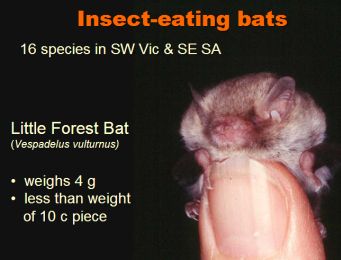
The Little Forest Bat is a species that would most likely be flying over peoples homes in the summer months feeding on insects such as mosquitoes.
Roosting
Cave roosting
There are four species of cave roosting bats in Victoria. The Southern Bent-wing bat and the Eastern Bent-wing bat, both cave roosting bats which are extremely dependent on the viability of one or two maternity caves which provide the necessary conditions for raising juvenile bats and supporting the ongoing viability of the entire population. It is extremely important that there is minimal disturbance in caves.
Tree roosting
There are 21 species which roost in tree hollows; some are specialists requiring dead trees, others only roost in live trees containing spouts. The female Lesser Long-eared Bat only roots in large cracks in dead trees to give birth. It important to recognise the value of both dead or live trees which can contain hollows or even cracks which bats can use.
Old paddock trees provide valuable habitat for many species of bats, some species will use cracks in the tree or under the bark whilst other species will use hollows or dead spouts. Some species will even use cracks in old fence posts where there is a shortage of natural roosting habitat.
Buildings are sometimes used by insectivorous bats for roosting;. They do not cause structural problems and do not eat through wiring etc. Generally their presence in eating insects outweighs any problems.
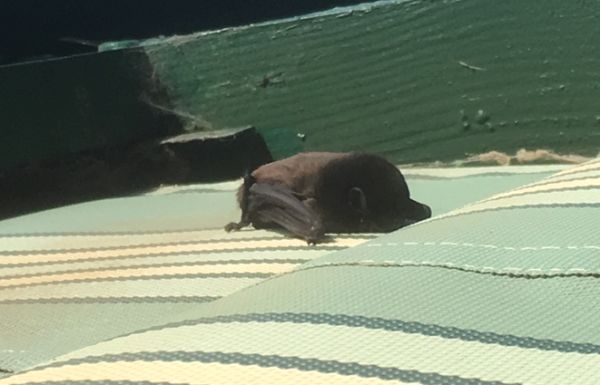 Gould’s Wattled Bat
Gould’s Wattled Bat
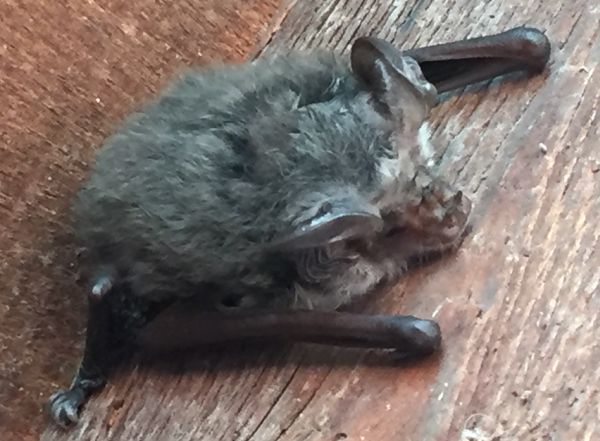 Lesser Long-eared Bat
Lesser Long-eared Bat
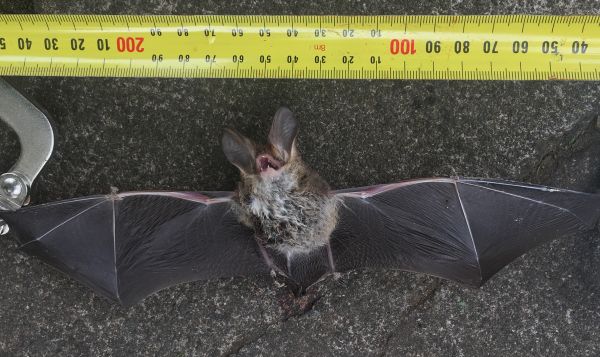 Lesser Long-eared Bat
Lesser Long-eared Bat
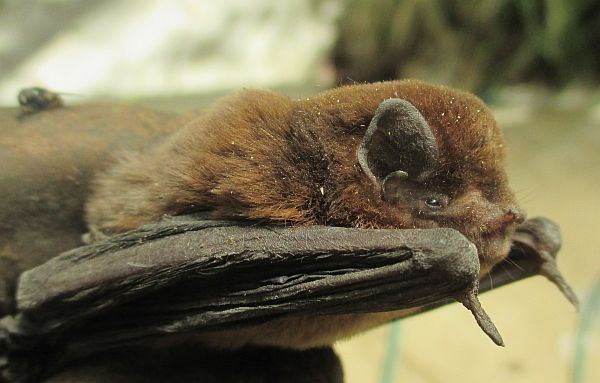
Chocolate Wattled Bat
Don't disturb bats
Disturbance to bats in overwintering caves needs to be avoided. There are cases where bats have fallen to their death because they try to fly in a state of torpor. Long term impacts are not readily seen. Each time a bat comes out of torpor they use up valuable fat reserves. If there are multiple disturbances there is a high probability they will not have enough energy to feed in the spring and starve to death.
Disturbance during summer has been identified as a problem in some areas where tourists and holidaymakers enter caves, which is likely to result in bats fleeing the cave in daylight and using valuable energy reserves and making them more prone to predators. Repeated disturbance can result in abandonment of the cave. Disturbance has been identified as an issue in some areas along the coastline where otherwise perfectly good caves have been rendered unsuitable, sometimes forcing bats to use much smaller caves and crevices that are marginal habitat, which can only support low numbers.
More details:
- SWIFFT Seminar notes - Bat Conservation
- SWIFFT Seminar notes - New insights into the secret lives of bats
- SWIFFT video conference notes - Bat ecology
- Southern Bent-wing Bat National Recovery Team
- Melbourne bat box monitoring program
- Southern Bent-wing Bat
- Land for Wildlife Notes on nest boxes, including bats
- More nature observations



